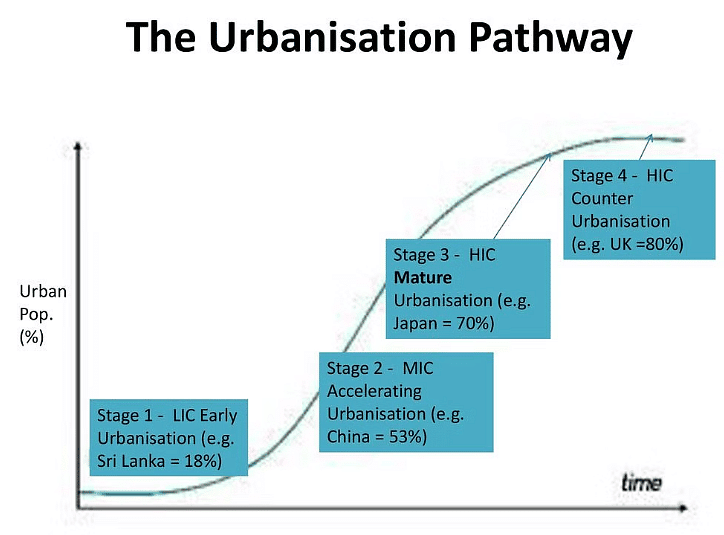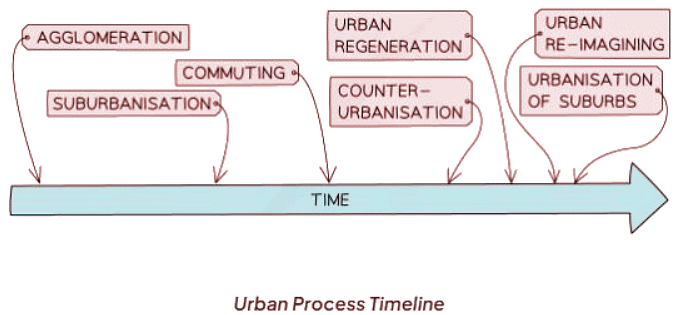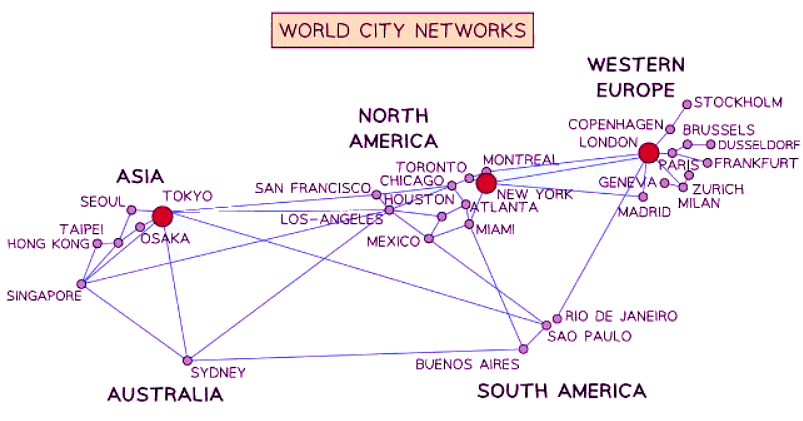Urban Growth | Geography for GCSE/IGCSE - Class 10 PDF Download
Urbanisation
- More individuals now reside in urban areas than in rural regions.
- Urbanization, the rise in the proportion of a population living in urban areas, varies worldwide.
- Urban settlements differ from rural ones in several aspects:
- Lifestyle: Urban areas have a faster-paced way of life.
- Size: Urban settlements are typically larger.
- Building and population density: Urban areas are characterized by compact and high-density structures.
- Economy and employment: Urban areas are hubs for finance, services, and manufacturing.
- The highest levels of urbanization are observed in more economically developed countries (MEDCs), while Africa and Southeast Asia exhibit the lowest levels.
- Between 1950 and 2015, the global population doubled, but urban populations more than tripled due to:
- Industrial decline in developed nations, prompting industries to relocate to emerging countries with cheaper labor, incentives, and tax breaks. This resulted in industrial growth in emerging economies, attracting people from rural areas to urban centers in search of improved living standards and employment opportunities.
- High rates of urbanization in less economically developed countries (LEDCs) are driven by:
- Concentration of new economic development in major cities.
- Push-pull factors leading to significant rural-to-urban migration.
- Urban areas experiencing higher rates of natural population growth.
Factors Affecting Urbanization Rates
Speed of Economic Development
- Economic growth is a significant driver of urbanization.
- The faster the growth of secondary and tertiary employment sectors, the quicker urbanization occurs.
Rate of Population Growth
- Economic growth necessitates a supply of labor.
- This demand can be fulfilled through natural urban population increase or rural-urban migration.
- Rural-urban migration is crucial as it attracts a broader workforce to urban areas.
Urbanization Trends
- Urban areas require a steady influx of labor to sustain economic growth.
- Natural increase in urban population - represents a gradual method of fulfilling demand
- Rural-urban migration - serves as a crucial labor source by attracting a diverse workforce to urban areas
- Rates of urbanization are comparatively lower in More Economically Developed Countries (MEDCs) due to a larger urban population percentage
- In 1900, only two cities, London and Paris, were classified as 'millionaire' cities. By 2018, this number escalated to 512.
- With ongoing urban expansion, the term 'mega city' denotes cities with over 10 million inhabitants. In 1970, there were merely four such cities. By 2000, the count reached 15, and by 2018, it soared to 33, with Tokyo housing nearly 37.3 million residents.
- The progression of urban areas is extending into rural zones, forming conurbations, thereby contributing to urban growth.
Causes of Fast Urban Expansion
Natural Increase
- Natural increase contributes significantly to urban population growth.
- This growth is mainly driven by reduced death rates and increased birth rates.
Urban Pull Factors
- Higher Wages
- Pace and Excitement
- Improved Education and Healthcare
- Better Job Opportunities
- Access to Public Utilities: water, gas, electricity, etc.
- Government Support
Rural-Urban Migration
- Rural-urban migration accounts for a significant portion of urban growth.
- This movement is influenced by both push factors from rural areas and pull factors from urban areas.
- Push factors include lack of basic services like healthcare and education, mechanization of farming, limited opportunities, and harsh living conditions.
- Urban pull factors, such as better job prospects and improved living standards, also contribute to this migration.
Rural push factors
- Limited access to healthcare and education
- Increased mechanization of farming
- Lack of job opportunities
- Insufficient government support and investment
- Harsh and monotonous living conditions
- Unreliable food supplies leading to famine
Rural Reclassification
- Some rural regions are reclassified as urban due to urban sprawl
- Rural villages are transforming into dormitory settlements
Urbanization Pathway
- A developmental pathway between Less Economically Developed Countries (LEDCs) and More Economically Developed Countries (MEDCs)
- Countries urbanize as they progress economically
- Urbanization pace slows down and may even decline during counter-urbanization

Urban Process Timeline

Urban Settlements Begin:
- Urban settlements start forming as people come together to trade and live.
- Small trading posts and villages emerge as hubs of activity.
Suburbanisation Process:
- Towns expand outward through suburbanisation, adding to the built-up area.
- New suburbs primarily consist of houses, alongside workplaces and services.
Dormitory Settlements:
- Residents move out of the city and commute for work, living in dormitory settlements.
- These settlements maintain ties with urban areas, utilizing city services and amenities.
Urbanization involves a series of stages, from the inception of urban settlements to the development of suburban areas and the establishment of dormitory settlements. This progression reflects the dynamic nature of urban growth and the evolving patterns of human habitation.
The Evolution of Residential Areas
- Modern suburbs contribute to urban sprawl, characterized by lower building densities compared to older town sections.
- New suburban areas primarily consist of residences but also host workplaces and amenities.
Dormitory Settlements
Urban settlements thrive, prompting individuals to relocate to dormitory settlements, where they primarily sleep.
- Residents maintain ties with their original cities or towns.
- They access urban services, shopping facilities, education, and healthcare despite living outside city limits.
Counter-urbanisation
Counter-urbanisation refers to the movement of individuals from urban areas to the surrounding rural regions.
Causes of Counter-urbanisation
- Increased Mobility and Accessibility: Factors such as higher personal car ownership, improved public transport, and expanded road networks have made rural areas more easily accessible to urban dwellers.
- Economic Factors: Rising wealth levels have made housing and travel more affordable for individuals, encouraging them to seek residences in rural settings.
- Agricultural Decline: Mechanisation and the consolidation of farms have freed up land for housing purposes, leading to the displacement of agricultural workers from these areas.
- Influence of Green Belts: The presence of green belts has pushed individuals to move further out in search of the rural lifestyle they desire.
- Secondary Homes and Early Retirement: The trend of acquiring second homes and opting for early retirement has facilitated the migration of city residents to rural areas.
Urban Regeneration and Re-Imaging
- Urban regeneration and urban re-imaging are different.
- Urban regeneration is the investment of capital in the revival of old, urban areas by either improving what is there or clearing it away and rebuilding.
- Over time, older parts of urban areas would begin to suffer a decline. Factories would move elsewhere, resulting in job loss. Quality of life and housing become poorer, and people move away. Urban blight sets in.
- The area needs to be 'brought back to life' which is termed as urban regeneration.
- Urban re-imaging involves changing the image and reputation of an urban area and the way people view it.
- It focuses on establishing a new identity or function and enhancing the quality and appearance of the built-up area.
- An example of successful urban regeneration is the redevelopment of London Docklands which led to the introduction of new industries, executive services, homes, entertainment, and leisure facilities, transforming it into a popular destination.
- Together, urban regeneration and urban re-imaging contribute to the rebranding of urban regions.
Megacities
- Urban regions with populations exceeding 10 million inhabitants.
- In 2007, a shift occurred where more individuals resided in urban settings than in rural ones.
- Projections suggest that by 2050, over two-thirds of the global populace, roughly 7 billion people, will call urban areas home.
- The rapid expansion of urban environments represents the swiftest growth in human history.
- Asia demonstrates the most significant development in megacities.
Reasons for Growth
Four main factors:
Economic Development
- Economic progress stimulates population expansion, increasing the demand for goods and services.
- Megacities serve as vital service hubs within the formal economic framework.
- In LEDCs, megacities also function as significant manufacturing centers, like Mumbai and Dhaka, with a large informal workforce.
Population Growth
- Youth are attracted to megacities due to their liveliness, rapid pace, and abundant opportunities.
- Internal growth occurs as urban migrants have children, perpetuating population expansion, as seen in cities like Mexico City and Mumbai.
Economies of Scale
- Centralizing the provision of goods and services in one location proves more cost-effective than spreading them across multiple cities.
- Local governments save finances on infrastructure development due to centralized communication and transport, leading to time and cost savings.
Multiplier Effect
- As a city thrives, it becomes an attractive destination for individuals and businesses alike.
- This attractiveness stimulates investment influx from various sources.
- Consequently, further development and expansion ensue, creating additional demand for skills, labor, and job opportunities.
- This cyclical process amplifies the positive impacts, resulting in sustained growth, as exemplified by San Francisco and its digital sector evolution.
World Cities
- Megacities possess a strong allure for both people and enterprises.
- These urban centers wield significant influence over surrounding regions.
- Global cities, irrespective of size, hold sway on a worldwide scale, carrying prestige and power.
- They serve as vital nodes within the global economic framework.
- The top three alpha world cities—London, New York, and Tokyo—function as pivotal financial hubs globally.
- These cities are supported by smaller networks of world cities that contribute to their economic ecosystem.
- Notably, only four world cities exist in the Southern Hemisphere: Sydney, Rio de Janeiro, Sao Paulo, and Buenos Aires.

|
55 videos|68 docs|78 tests
|
FAQs on Urban Growth - Geography for GCSE/IGCSE - Class 10
| 1. What are some factors that can affect urbanization rates? |  |
| 2. What are some causes of fast urban expansion? |  |
| 3. What is the urbanization pathway? |  |
| 4. What is counter-urbanisation? |  |
| 5. Why is urban regeneration and re-imaging important in cities? |  |




















